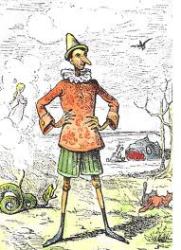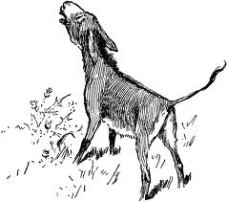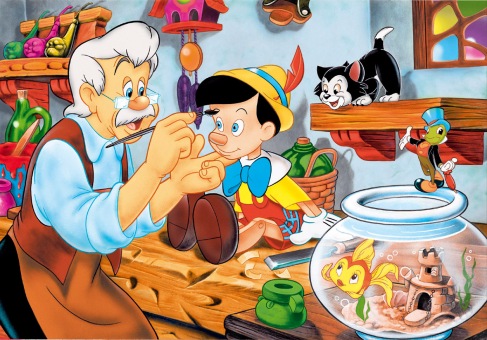In Clark’s essay, “The Case of American Fantasy,” she mentions the popular idea, in LGBT sub-culture, that Dorothy’s companions are potentially homosexual, or at least not the stereotypical heterosexual man. There is a sense that the lion is ‘born to be a sissy,’ expressing that he is an effeminate male figure. This is obvious, perhaps, from his sensitive claws, upon touching the tin man’s body.
Within the sphere of gay culture, there are numerous types of gay men, include the term ‘Bears’, which are composed of a group of muscular, many looking men, who often possess quite a lot of chest hair, but tend to be quite tender at heart. It is not far fetched to claim that, if one were to look at The Wizard of Oz under such a lens, that the cowardly lion might fit into such a category.
Certainly, the idea of the tin man and the scarecrow, both men desiring what the other apparently has no need for, might be considered a good pair. To desire a mind, one might say is quite masculine; whereas to desire a heart is more effeminate. One could imagine a new family, with the tin man and the scarecrow as the parents, with the lion as perhaps the protective older brother.
Having not studied Baum’s life, it is difficult to discern whether or not he, himself, could have intended such a portrayal, but, regardless of whether or not it was intended, the fact that this vision is shared by many, is powerful in and of itself. It expresses the potential for such a family to exist, and raises social awareness of this homosexuality, and the homosexual family, in a non-threatening and pleasing manner, which can raise hope of acceptance.
Regardless of Baum’s intentions, in terms of homosexuality, his message about masculinity is clear. You do not have to be a handsome prince, of flesh and striking features, charm, wit, and courage to save the heroine; for even a tin man, a lion, and a scarecrow are worthy heroes.

Gay Theory and The Wizard of Oz
Politics and Nonsense
In Lewis Carroll’s Through the Looking-Glass, there are among the nonsense some very lucid thoughts and not-so-subtle political commentary. Chapter VII “The Unicorn and the Lion” is an excellent example of these allusions. The footnotes explain the correlation of the nursery rhyme and its link to the ongoing conflict between the English and Scottish kingdoms within Great Britain, and as the scene plays out in the story, it further reinforces this link.
Historically, there has been a division between the English and Scottish kingdoms, even after they united in the early 1700s. The rhyme presented in Looking-Glass uses the symbols of the Lion – from the English coat of arms – and the Unicorn – found on the Scottish coat of arms – in constant conflict:
“The lion and the unicorn were fighting for the crown:
The lion beat the unicorn all around the town.
Some gave them white bread, and some gave them brown:
Some gave them plum-cake and drummed them out of town.” (Carroll, 198)
The rhyme speaks to the political relationship between the two kingdoms and their infighting. In Looking-Glass, Carroll’s Lion and Unicorn – who the artist Tenniel caricaturizes as Ewart Gladstone and Benjamin Disraeli respectively – have been fighting for quite a while. The king, upon hearing from his messengers, goes to watch.
“The King was evidently very uncomfortable at having to sit down between the two great creatures; but there was no other place for him… the poor King was nearly shaking [the crown] off his head, he trembled so much… he was very nervous, and his voice quite quivered.” (Carroll, 202)
Interestingly, the notes state that the caricatures were principally Tenniel – who was a political cartoonist – and Carroll may not have even intended this association. However, as the situation develops, and as the two fighters take their rest, the King becomes increasingly afraid of the two bestial titans:
Considering whether Carroll was involved, the scene can be interpreted as a commentary on how the British monarch was becoming increasingly caught between the struggles of Parliament; the well-known political feud of Disraeli and Gladstone becomes then the reason the King is frightened by the battle. This would effectively “implicate” Carroll in the politics of the scene.
The whole point of this post then, is to suggest that the nonsense in Through the Looking-Glass may not be as much nonsense as the reader is led to believe.
Pinocchio the Jackass
Symbolism of the Donkey
Collodi’s version of Pinocchio is an obvious attempt to teach young boys, or children in general, how to be good, but the severe punishments are atypical to techniques used in many other children’s literature stories of the time. One particular punishment Pinocchio endures that puzzled me was his transformation into a donkey. Why a donkey? Why did the author choose this animal over others? What traits or characteristics does the donkey possess that would parallel the wrongs of the boys?
In Italy, where the original tale was written, the donkey symbolized stupidity or lack of use of the brain. Depicted in the tale as well as the most recent Disney adaptation, the place where children go to escape is intended to bring out idiotic behaviors or to “make jackasses out of the boys.” In the tale, the children literally turn into jackasses (another name for donkey) when they reach a certain level of stupidity or when enough time has passed so that it is unlikely the children will ever recommit to their studies.
Donkeys also can depict laziness, which mirrors the boy’s actions in this chapter of the story. In this case, the donkey symbolizes the desire to not do anything productive but to spend time playing and avoiding responsibilities.
In the 1940 Disney film, you can see the degree to which the “curse” transforms the boys due to level of idiocy, mischievous behaviors, or the level of inherent “jackassness” depicted by the individual. The boys who were not as ill mannered kept their voices for longer or transformed at a later date all together. Those who were good in their heart and core were unaffected, such as the cricket in the Disney film whom spent a long period of time in the play land but was not affected at all. This condition of the transformation implies that the transformation was only intended to bring out what is already underneath the surface. No jackass will be displayed if one is not already a jackass by personality (clever Collodi.)
This relates back to Collodi’s underlying impression of little boys in general: they are all jackasses at some level, but some are more than others. The transformation of boys to donkeys in Pinocchio is meant to externalize the boys’ inner character.
Let me start off by saying I am a diehard Disney fan. There are people who will say that he was an anti-Semite or that he hated children, and to that I say, there are a lot of people who do good things for the world who didn’t necessary have great personal lives.
So that being said, the article “Breaking the Disney Spell” by Jack Zipes made me absolutely angry. Down to the very rhetoric he uses, referring to Disney’s “stranglehold” over the fairy tale, and his “capitalization of American innocence”. This is obviously a man with a vendetta. I don’t know what Walt Disney did to make Jack Zipes so angry, but it definitely comes out in this article.
At one point, he writes, “Throughout the entire production of this film, Disney had to be consulted and give his approval for each stage of development”. But then he goes onto write, “As we know, Disney never liked to give credit to the animators who worked with him, and they had to fight for acknowledgment. Disney always made it clear that he was the boss and owned total rights to his products.”
Already, I have an immediate problem with this statement because if it’s really true that Disney had a hand in every aspect of the production of the film, doesn’t that entitle him the label of “boss” and doesn’t he truly own total rights to the product? He even makes a strong point about how his re-telling of Snow White is truly his Americanized version that just totally strips the Grimm brothers of the traditional meeting. If he totally remade the story in an entirely new way, doesn’t that make him the owner of the product more than if he had just adapted the story directly to film?
And as for the other assertion, that his animators had to fight for acknowledgment, I give you this, displayed in the opening seconds of Snow White and the Seven Dwarfs:

Enough said.
Jack Zipes honestly has some huge problem with Disney and his style of bringing traditional fairy tales to life. I don’t see the problem in adapting the stories, because isn’t that how we are left with the versions we have today? From a variety of different people in different places passing the stories on to their children where they get altered a little or sometimes even a lot? Disney is just another one of those story tellers who chose to adapt the story to his own taste. Whether that taste is “Americanized” or not really isn’t the point. He gives our children a story to watch on screen and relate to. Would you rather read your child a story about a mermaid who cuts out her tongue, is in constant pain, and then almost stabs the object of her affection, or would you rather give them a happy ending?
I see absolutely nothing wrong with Disney’s adaptions and I’d really like to know what Jack Zipe’s beef is. He didn’t die a billionaire for nothing.
“The most important thing we’ve learned…”

Didactic literature in human form…AH!
Looking beyond power dynamics and the intricacies of academic dialogue on the nature of didacticism in children’s books, it is necessary to remember that all works of literature, for any age, are acting on some level as teaching tools. This teaching need not be heavy handed, with harsh morals and punishments like that found in evangelical texts for children from the eighteenth and nineteenth centuries. However, lessons are always being passed along through literature. Even as adults we are still learning through fiction, even if it is packaged through the pleasure of the aesthetic presentation, we are still being exposed to different perspectives and broadening our understanding of who we are as individuals and of the world we view through the lens of the novel; with every page we are learning how to be people.
.jpg)

With this in mind, it is essential then that stories for children actually teach them something. However, this teaching does not need to be conventional. It does not need to be didactic and saccharine, in fact if it is, it will fail as a book. Children are indeed some of the toughest and honest critics and to use Stevenson’s term, a book that fails to entertain, that fails to draw in its readers will not be honored with the “children’s imprimatur” (Stevenson 118). Carpenter lays out this idea of the entertainment/morality balance in his essay, between the child’s desire for “adventure and imagination” and the adult’s desire for “moral examples” (Carpenter 1).
However in reading this essay, a statement that followed soon after this balance discussion caught me off guard. Carpenter goes on to say that in order for a text to be successful it must indeed fulfill these two desires, however he says that every once in a while a book comes along which achieves success despite failing to satisfy both parties. He gives Roald Dahl’s Charlie and the Chocolate Factory as his example stating that is “has been loved by children and hated by adults because it is full of fun and virtually amoral” (Carpenter 1). Was I the only one that found this strange? It was even stranger that Carpenter failed to give any support for his statement, leaving it merely as a given that everyone finds Dahl’s novel “amoral”. The first thing that came to mind was, I don’t know of any other book that has so many lessons and morals, some even explicitly spelled out, but in a way that is hilarious and entertaining. Dahl creates the ideal model for children to follow in the character of Charlie, and he then has four characters that exhibit extremes of what children should not be like. One of the most memorable excerpts from the novel is the Oompa-Loompa song directed at parents (if you’d like to hear it sung and watch it performed, it’s actually included in the Tim Burton film, check it out here):
“The most important thing we’ve learned,
So far as children are concerned,
Is never, NEVER, NEVER let
Them near your television set —
Or better still, just don’t install
The idiotic thing at all…
did you ever stop to think,
To wonder just exactly what
This does to your beloved tot?
IT ROTS THE SENSE IN THE HEAD!
IT KILLS IMAGINATION DEAD!
IT CLOGS AND CLUTTERS UP THE MIND!
IT MAKES A CHILD SO DULL AND BLIND
HE CAN NO LONGER UNDERSTAND
A FANTASY, A FAIRYLAND!
HIS BRAIN BECOMES AS SOFT AS CHEESE!
HIS POWERS OF THINKING RUST AND FREEZE!
HE CANNOT THINK — HE ONLY SEES!
What used the darling ones to do?
Have you forgotten? Don’t you know?
We’ll say it very loud and slow:
THEY … USED … TO … READ! They’d READ and READ,
AND READ and READ, and then proceed
To READ some more. Great Scott! Gadzooks!”
As I continued to think about Dahl’s novel and it’s relation to didacticism/morality and entertainment, I realized in a way, Dahl is doing for children’s books what Flannery O’Connor did for her adult readers. They both utilize the shock factor, they stay clear of heavy-handed didacticism. But they are in no way elevating or suggesting that readers should follow in the footsteps of the many amoral characters that populate the pages of their stories. Instead, they both utilize the grotesque in order to shock their readers and bring a realization of how they as people should act. Moreover the grotesque in a way brings on a sort of grace and salvation. And in Dahl’s case this produced not only for his readers, but also for the amoral children in his story because although they are cruelly punished, they do not perish, they come out alive, but severely altered, ready to start out on a better and more enlightened path, a path which we as readers are able to take without having to actually learn it the hard way.

Works Consulted:
Humphrey Carpenter’s “Secret Gardens”
Deborah Stevenson’s “Classics and Canons”
Roald Dahl’s Charlie and the Chocolate Factory
Jon M. Sweeney’s article from American Magazine, “Grace and Grotestque” (http://americamagazine.org/issue/701/ideas/grace-and-grotesque)





